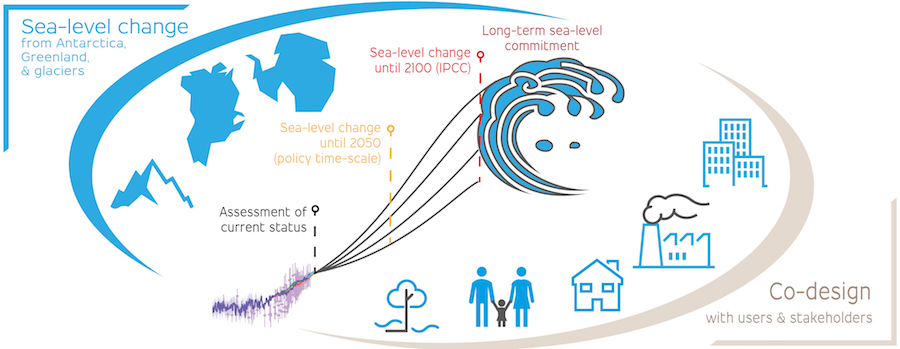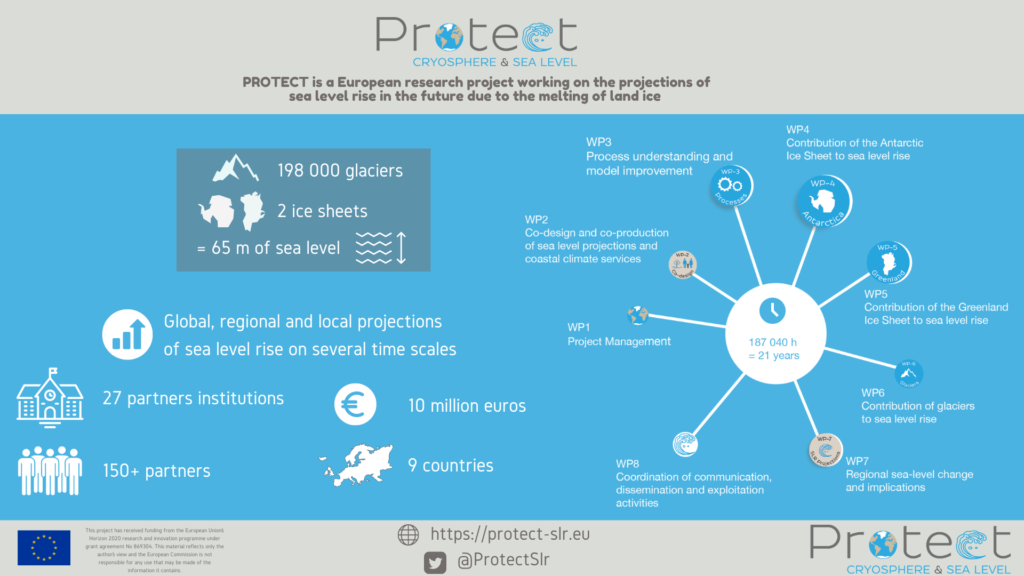
The overarching scientific objective of PROTECT is to assess and project changes in the land-based cryosphere, with fully quantified uncertainties, in order to produce robust global, regional and local projections of SLR on a range of timescales. The project will place particular emphasis on the low-probability, high impact scenarios (referred to as high-end scenarios hereafter) [Stammer et al., 2019] that are of greatest interest to coastal planning stakeholders. A novelty in PROTECT is the strong interaction between these stakeholders and the sea-level scientists, ranging from glaciologists to coastal impact specialists, to identify relevant risks and opportunities from global to local scales and enhance European competitiveness in the provision of climate services.
The comprehensive spectrum of expertise allows PROTECT to cover, for the first time, all spatial and temporal scales that are relevant for future SLR. PROTECT will achieve the following specific objectives:
- Assess the contemporary mass balance of ice sheets and glaciers, quantify the relative importance of anthropogenic forcing and internal climate variability to ice sheet and glacier changes, and use remote-sensing observations to evaluate and improve the models used for ice sheet and glacier projections. To meet this objective, PROTECT will use and develop data products from the ESA Earth Observation Programme and Copernicus climate data.
- Use the improved understanding of short-term variability in glacier and ice-sheet mass balance to make projections until 2050, the time scale of relevance to many of today’s coastal management decisions. This mainly concerns the melting of glaciers and key areas of significant contemporary ice sheet mass loss in West Antarctica (Amundsen Sea embayment and Antarctic Peninsula) and the ablation zone and dynamical response time of major outlet glaciers of the GrIS (e.g. Jakobshavn Isbrae).
- Use a range of newly-developed, coupled climate-ice sheet models to project SLR as a result of glacier and ice sheet mass change until 2100, the IPCC timescale that is relevant for long-term infrastructure planning. Improved understanding and modelling of critical cryosphere processes and feedbacks will better characterise the probability of high-end SLR under plausible climate-change trajectories.
- Assess the irreversibility of glacier and ice-sheet mass loss and the associated SLR commitment to 2500 and beyond, the timescale relevant to the long-term viability of coastal cities, small islands and low-lying states. This requires an understanding of the conditions needed for glacier and ice-sheet regrowth and their likelihood under strong mitigation of anthropogenic greenhouse-gas emissions.

